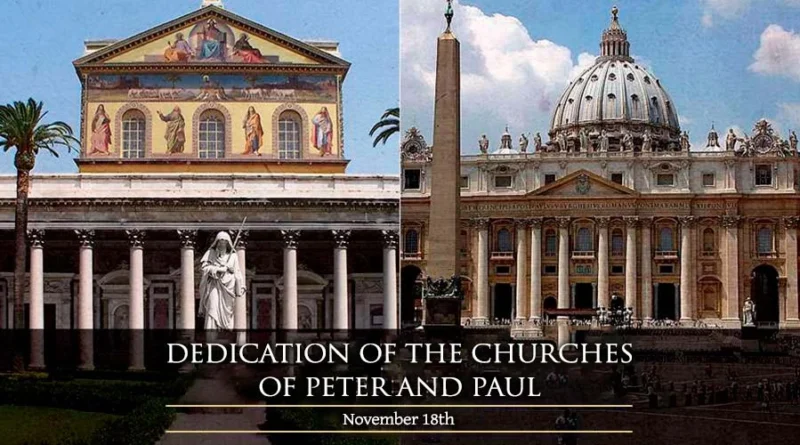Rome Honors the Legacy of Peter and Paul
Rome Honors the Legacy of Peter and Paul
A Feast That Connects Faith and History
Every year on November 18, Catholics across the world mark a feast rich in history and meaning. It is the Dedication of the Churches of Peter and Paul, a celebration that honors two historic basilicas in Rome. These churches carry the stories of courage, faith and the early Christian movement. As major basilicas, they draw countless visitors who seek prayer, reflection or a deeper sense of connection to their roots.
Saint Peters Basilica stands as a symbol of Christian devotion. Its beauty and size make it known across the world. Although many admire the building, fewer people know the long journey behind it. In the year 323, Emperor Constantine ordered the first basilica to rise over the burial place of Peter the Apostle. Peter served as the first Pope and guided the early Christian community during difficult times.
The original structure stood for more than one thousand years. During that period, believers traveled from far and near to pray there. As time passed, the building weakened. Its walls could no longer support its weight. Pope Julius II, after careful thought, decided to bring down the old structure. His choice created room for a new beginning and a stronger future.
The Long Journey of Saint Peters Basilica
Work on the new basilica began with hope and ambition. The project stretched across more than two hundred years. Architects and artists of the Renaissance added their genius to the design. As decades passed, the church grew into a masterpiece of art and faith. When workers completed it, the basilica shone as a symbol of renewal.
The dedication took place on November 18, 1626. Since then, Saint Peters has drawn millions every year. People come from around the world to stand in the vast square, look up at the dome and reflect in the peaceful interior. Many describe their visit as moving. Others say it brings them closer to their spiritual roots. Whatever the reason, the basilica continues to inspire hope.
Across Rome, another treasure tells its own powerful story. Saint Pauls Basilica offers a quiet yet commanding presence outside the ancient city walls. It stands on the place believed to be the burial site of Paul the Apostle. Paul influenced the early Church through his missionary journeys and his bold letters. His words shaped Christian teachings and encouraged believers to remain strong in their faith.
Emperor Constantine also ordered the first building of Saint Pauls Basilica. For centuries, it stood as the largest church in Rome. Pilgrims came to honor Paul and learn from his example. The basilica served as a place of prayer, study and reflection. Through its doors passed believers who wanted to understand the life of an apostle who changed the direction of Christianity.
ALSO READ : Christians in Pakistan Seek Fair Representation
The Fire That Brought New Life to Saint Pauls
In 1823, a devastating fire destroyed much of the basilica. News of the tragedy spread quickly. Across continents, people felt the loss. Church leaders, communities and nations responded with support. Donations arrived from different parts of the world. Their generosity showed how deeply the basilica touched the hearts of many.
The rebuilding process moved with a spirit of unity and determination. Workers shaped a new basilica that honored the past while offering fresh beauty. When the reconstruction ended, Pope Pius IX consecrated the church in 1854. Saint Pauls rose again, stronger and brighter.
Today, the basilica welcomes visitors into a peaceful space. Its courtyard encourages quiet reflection. Tall columns, gentle light and a sense of calm help visitors slow down. Many describe the experience as a journey back in time. Others feel that every corner of the basilica tells a story of faith and endurance.
Two Apostles, One Shared Mission
Although Saint Peters and Saint Pauls stand in different parts of Rome, their stories connect. They honor two apostles who devoted their lives to the Gospel. Peter brought leadership and stability to the early Church. Paul traveled across regions to spread the message of Christ. Both men met their final moments in Rome. Their courage shaped the foundation of Christianity.
The feast of their dedication invites believers to reflect on more than the buildings. It reminds the world that these churches grew from faith, sacrifice and vision. With every passing century, they remain as symbols of hope. They show how faith survives challenges. They also remind people that history continues through those who live out its message.
Visitors describe a deep sense of connection within these basilicas. Some feel moved by the lives of Peter and Paul. Others find strength in the stories preserved in stone, art and tradition. Even non Christians visit to admire the architecture and learn about the roots of early Christianity.
Why This Celebration Still Matters
The feast on November 18 grows more meaningful each year. It points believers back to their spiritual foundation. It also highlights the link between history and present day faith. As people walk through the basilicas, they step into a living story that began long ago.
Tourists arrive with interest. Families come with hope. Scholars explore details of the early Church. Pilgrims bring prayers and leave with renewed strength. The flow of visitors never stops, and the basilicas continue to offer comfort and inspiration.
The Dedication of the Churches of Peter and Paul stands as a reminder that faith outlasts time. These buildings do not simply hold art and stone. They hold stories of belief, endurance and unity. Through them, the legacy of Peter and Paul continues to shine.
Content Credit : Boluwatife Abiola
Image Credit : Google. Com




